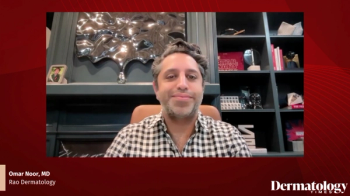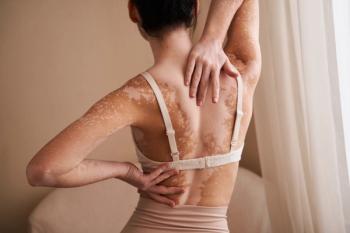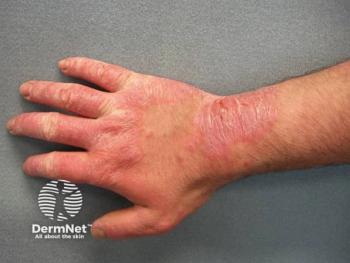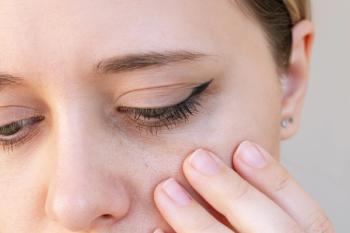
- Dermatology Times, July 2025 (Vol. 46. No. 07)
- Volume 46
- Issue 07
Below the Surface: Dermatologic Procedures for Hidradenitis Suppurativa
Key Takeaways
- Hidradenitis suppurativa (HS) involves painful abscesses and lesions, affecting patients' quality of life and requiring comprehensive management.
- Recent advancements in HS pathophysiology have led to effective treatments, including hormonal agents, antibiotics, biologics, and procedural interventions.
Our July cover story explores effective treatments for hidradenitis suppurativa, including procedural interventions and advanced therapies that enhance patient quality of life.
The first time I met a patient with hidradenitis suppurativa (HS), I was a first-year dermatology resident who had never heard of this condition. I was shocked by the extent of the disease and its social and emotional toll on patients. As my dermatology training went on, I realized that many patients with HS had very advanced disease. Numerous patients described their traumatic experiences with the health care field. In HS, painful abscesses and lesions often drain, and they usually appear on the genitals, buttocks, inframammary areas, and axillae. Patients explain the significant impact on their quality of life and how they have had to adjust to cope with their disease.1 Although systemic medical therapy remains first line, procedural interventions are crucial for targeted lesion clearance and symptom control, especially in moderate to severe cases.1,2
Thankfully, research findings have advanced our understanding of HS pathophysiology over the past few years. This has led to more effective, refined treatments that are often used in combination to tailor treatment plans for each patient. These medical treatments include hormonal agents, oral and topical antibiotics, and biologics. We have found that these treatments can be very effective with the addition of timely procedural interventions.1-3 The type of procedure depends on the discussion with patients about their preferences, Hurley stage, disease severity, and location of lesions.1
Addressing Acute Flares
I recently had a 35-year-old woman with a 14-plus-year history of HS come into the clinic for surgical evaluation. She reported how she usually goes to the emergency department for an incision and drainage (I&D) when she has an acute flare on the abdomen or chest. She described the pain associated with the I&D and how it provided temporary, rapid relief.
Although I&D is a quick procedure that relieves pressure and pain for some HS lesions, dermatologists must counsel patients that it is not a great, definitive treatment for HS.1-4 It has a very high recurrence rate and should be mainly reserved for acute symptom management rather than long-term disease control.4,5
One of my preferred procedures for alleviating acute lesions is injecting intralesional corticosteroids. It is a simple and effective procedure where we directly inject triamcinolone acetonide (usually at a concentration of 20-40 mg/mL) into a painful nodule with a small-gauge needle. This type of injection can quickly decrease pain within 1 day. Patients often report fewer signs of inflammation within 7 days, making it the go-to procedure for acute localized lesions.6,7 This quick and cost-effective procedure can be done in the clinic and hopefully keep patients out of the ED.
Deroofing and Excision
Deroofing is another procedure that has become popular for treating persistent or recurrent nodules and sinus tracts. Also known as unroofing, it is a very effective procedure where we remove the top of the nodule, sinus tract, or abscess but leave the underlying tissue to heal by secondary intention.3-5 Patients then do twice-daily or daily wound care until the wound bed has epithelialized over a few months. By removing the roof of the inflammatory lesion, we decrease the chronic inflammatory burden from the skin. This leads to less overall pain and drainage, with a significantly lower recurrence rate than I&D.2,3 Deroofing is best for patients with Hurley stage I or II disease, but depending on patient preference, we sometimes perform this technique for Hurley stage III, as well.
I have had patients interested in deroofing for multiple or individual lesions within a specific area. Research data show that deroofing is safe, effective, and well tolerated. Most patients report low postoperative pain and high satisfaction.2-4 One of the most promising aspects of deroofing is that its recurrence rates are reported to be as low as 10% at 3 and 12 months.2
Next, surgical excision is best for patients with more severe and chronic disease who fit into Hurley stage II and III. Surgery is the gold standard for long-term local HS disease control.1,3,5 Sometimes, if the affected areas are localized, we can do a local excision and surgically remove individual lesions.1-3 If a larger amount of skin is affected by HS and has numerous scars, sinus tracts, and nodules, then wide local excision can be used and has low recurrence rates.
We remove a large amount of tissue, which sometimes requires skin grafts or flaps if the area can’t be closed primarily or the patient does not want to do secondary intervention.1,5 For these excisions, we encourage the patients to stay on their medical treatments, given that HS is a systemic disease and new lesions can occur anywhere on the body.1-5 It is imperative that patients maintain continuing medical management in addition to new surgical procedures for the best outcomes.
The Role of Lasers in HS
Laser therapy can offer patients with HS a more minimally invasive approach than excision.1,2 Carbon dioxide laser excision can excise or vaporize nodules and sinus tracts.1,5 The laser can precisely target the lesion for destruction without involving much of the surrounding normal tissue. This can lead to faster healing rates, and data indicate lower postoperative pain than traditional surgical deroofing for tunnels.2,5
Additionally, one of my preferred lasers for HS is laser hair removal. It uses the long-pulsed Nd:YAG or alexandrite lasers for hair removal, which destroys hair follicles and reduces follicular occlusion, bacterial colonization, and inflammation.1,2,8,9 Study findings demonstrate high response rates with the alexandrite laser and significant improvement in HS severity with the Nd:YAG laser.8,9 Although often used as an adjunctive therapy in HS patients with mild to moderate disease, the Nd:YAG laser as a preventive measure for flares in affected areas.8,9
Adjunctive Procedures
Several emerging procedural therapies can be used as an adjunct to the previously described procedures. First, cryoinsufflation is a quick procedure where we inject liquid nitrogen directly into sinus tracts. Evidence points towards its effectiveness currently, but more studies are needed.1,6 Liquid nitrogen is also commonly used in dermatology to treat lesions such as warts or actinic keratoses. Second, botulinum toxin injections have been approved for hyperhidrosis and have also been investigated for HS. Potentially, by reducing sweating and causing gland atrophy, they can lead to less inflammation.1,6
Botulinum injections can be used for areas of HS in the axillae. Third, setons are where nonabsorbent loops are threaded through sinus tracts to promote drainage and improve healing.1,7,10 These are a potential therapeutic for very complex or extensive perianal disease. These can help dermatologists to manage this disease as an outpatient procedure and minimally impact the patient’s daily activities.10
Integrated Care
The best management of HS often is multidisciplinary, with dermatologists playing a pivotal role in diagnosing the disease, directing HS medical management, and performing in-office procedures. For larger areas needing complex excisions around critical anatomy and reconstruction, we may have to collaborate with our colleagues in plastic surgery, general surgery, urology, or obstetrics and gynecology departments.5,12
Biologic medications such as adalimumab (Humira; AbbVie Inc), secukinumab (Cosentyx; Novartis Pharmaceuticals Corporation), and bimekizumab (Bimzelx; UCB, Inc) have been FDA approved for HS. These biologic medications are crucial for patients with moderate to severe HS to reduce flares and hopefully slow disease progression.11 Data from recent studies show that biologics, when combined with surgery, are associated with a faster decline in HS disease activity.
This treatment combination may also lead to milder recurrences with improved outcomes.5,12,13 Although there is debate, patients do not need to discontinue biologics before surgery. Continuing biologic treatment appears to be safe and does not necessarily increase postsurgical complications. Data from some studies show that biologics are associated with a longer wound healing time in some patients; however, anecdotally, I have not seen this in practice for our patients.12,13 The combination medical and surgical approach highlights HS’s complex and chronic nature, requiring an individualized treatment plan for each patient.
Conclusion
Procedural interventions are essential in the comprehensive management of HS. From treating acute flares with intralesional steroids to definitive excision and deroofing for chronic disease, we as dermatologists are empowered to alleviate symptoms and prevent disease progression in patients with HS.
These procedures can improve patients’ lives. As we continue to gain more knowledge of HS and how to integrate procedures, we become better equipped to provide more effective and patient-centered care. Many of these patients have endured HS for a long time; now we have tools to finally help them fight this disease one lesion at a time.
References
- Shams RB, Milanovic S, Sayed CJ. Procedural interventions for hidradenitis suppurativa. Dermatol Clin. 2025;43(2):285-299. doi: 10.1016/j.det.2024.12.012
- Vu TT, Soong LC, Hagtvedt R, Keeling CP. Surgical deroofing in the management of hidradenitis suppurativa alone or as an adjunct to medical therapies. Dermatol Surg. Published online March 17, 2025. doi:10.1097/DSS.0000000000004604
- Pena-Robichaux V, Goldberg S. Procedural treatments for hidradenitis suppurativa. J Am Acad Dermatol. 2024;91(6S):S46-S51. doi:10.1016/j.jaad.2024.08.072
- Krajewski PK, Sanz-Motilva V, Flores Martinez S, et al. Deroofing: a safe, effective and well-tolerated procedure in patients with hidradenitis suppurativa. J Eur Acad Dermatol Venereol. 2024;38(5):931-936. doi:10.1111/jdv.19810
- Sechi A, Caposiena Caro RD, Michelucci A, et al. CO 2 laser versus surgical deroofing for the treatment of hidradenitis suppurativa tunnels: a comparative multicentric, retrospective study. Dermatol Surg. 2025;51(4):389-395. doi:10.1097/DSS.0000000000004498
- Cuenca-Barrales C, Montero-Vílchez T, Sánchez-Díaz M, et al. Intralesional treatments in hidradenitis suppurativa: a systematic review. Dermatology. 2022;238(6):1084-1091. doi:10.1159/000524121
- Garelik J, Babbush K, Ghias M, Cohen SR. Efficacy of high-dose intralesional triamcinolone for hidradenitis suppurativa. Int J Dermatol. 2021;60(2):217-221. doi:10.1111/ijd.15124
- Tierney E, Mahmoud BH, Hexsel C, Ozog D, Hamzavi I. Randomized control trial for the treatment of hidradenitis suppurativa with a neodymium-doped yttrium aluminium garnet laser. Dermatol Surg. 2009;35(8):1188-98. doi:10.1111/j.1524-4725.2009.01214
- Sidhom S, Petry SU, Ward R, Daveluy S. Treatment of hidradenitis suppurativa with 755-nm alexandrite laser hair removal: a randomized controlled trial. JAAD Int. 2024;16:239-243. doi:10.1016/j.jdin.2024.04.005
- Lajevardi SS, Abeysinghe J. Novel technique for management of axillary hidradenitis suppurativa using setons. Case Rep Surg. 2015;2015:369657. doi:10.1155/2015/369657
- Mendes-Bastos P, Benhadou F, Venturini M, et al. Biologic drugs in hidradenitis suppurativa: what does the GP have to know? a narrative review. Front Med (Lausanne). 2024;11:1403455. doi:10.3389/fmed.2024.1403455
- Chang TH, Sheen YS, Liao YH. Surgical outcomes of hidradenitis suppurativa: evaluating factors influencing recurrence and complications after 284 complete excisions. Clin Exp Dermatol. 2024;49(12):1554-1560. doi:10.1093/ced/llae246
- Salvador-Rodriguez L, Cuenca-Barrales C, Arias-Santiago S, Molina-Leyva A. Neoadjuvant Biologic Therapy in the Surgical Management of Patients with Hidradenitis Suppurativa: A Cohort Study. Acta Derm Venereol. 2020;100(16):adv00257. doi:10.2340/00015555-3616
Articles in this issue
5 months ago
Dermatology Times July 2025 Print Recap5 months ago
Is AI Transforming Skin Care?5 months ago
The Value of RAD, According to Clinicians5 months ago
A New Canvas for Conversations in DermatologyNewsletter
Like what you’re reading? Subscribe to Dermatology Times for weekly updates on therapies, innovations, and real-world practice tips.



















